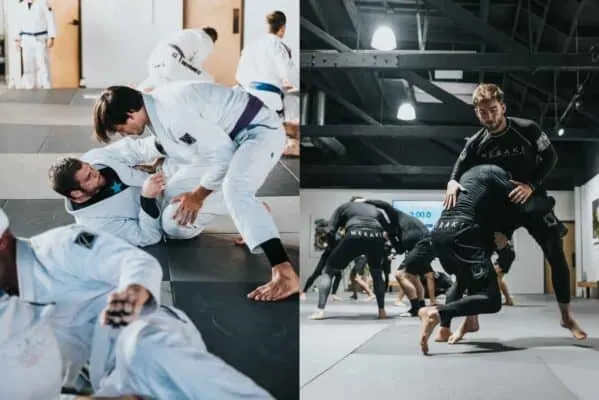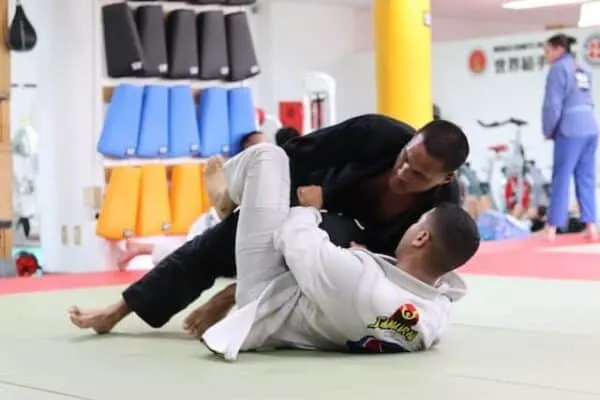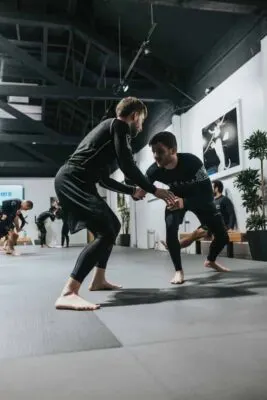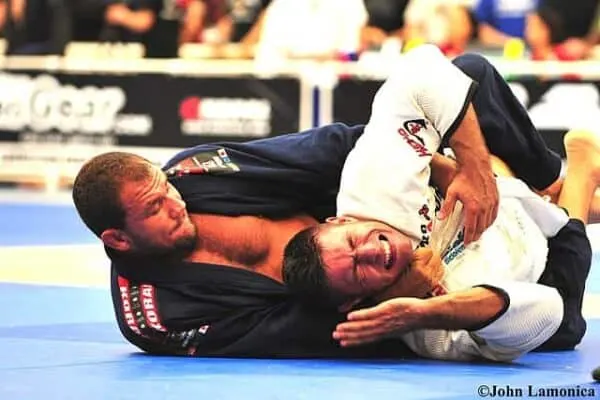
Whether you are in the grappling world or not, you have likely heard about the Gi vs No Gi Jiu-JItsu debate. It’s very unlikely that you didn’t, as this is one of the never-ending debates in the modern martial arts world. And in this article, you are going to finally find out all the differences and which one is better.
A “Gi” is a style of Brazilian Jiu-Jitsu (BJJ) where all athletes must wear a unique Gi uniform made out of thick cotton that includes a top/jacket, long pants, and a color belt rank. No Gi, as its name suggests, is a style where students do not wear the uniform, which makes it quite different in many aspects.
Gi BJJ is better than No-Gi BJJ if you want to learn practical techniques based on grabbing onto an opponent’s clothing. In contrast, No-Gi is better than Gi BJJ if you plan to become an MMA fighter, where you need to learn to apply techniques without grabbing onto an opponent’s clothing.
Sounds simple, right? Well, though similar, these two styles differ a lot in certain technical aspects, and you are going to learn all about it in this article.
Let’s dive right into it!
What is Gi BJJ?
A “Gi” is the most popular style of BJJ practiced by millions of people around the world. It is an initial style of jiu-jitsu developed way back in the 1920s by Carlos and Helio Gracie.

In this style, all students need to wear a unique “Gi” uniform. The uniform includes a jacket similar to the “judogi” top, long pants, and the color belt rank around the waist. In fact, the uniform is very similar to the one in Judo but is made out of lighter materials. Students must wear it both in training and competition, and they never do any exercises without it.
RECOMMENDED READING: What Do BJJ Gi Colors Mean? Answers for BJJ Gi
What is No Gi BJJ?
No-Gi BJJ is the modern style of BJJ where students do not have to wear a traditional Gi uniform (jacket and pants). Instead of a traditional uniform, students wear a rush guard, or just a shorts and a T-shirt.

The exact origins of this style are not clear, but the man who deserves a lot of credit for developing modern no-gi is BJJ legend Eddie Bravo who is also the founder of Combat Jiu-Jitsu.
Key differences between Gi and No-Gi Jiu-Jitsu
The difference in friction
Gi uniform creates a lot of friction during the grappling exchanges, notably when the uniform gets soaked with sweat. As a result, friction makes it harder for students to rely on sheer physical strength and speed to gain an advantage. Instead, they have to be patient, and focus more on technique and strategies to find a way to win.
Friction slows the action down and forces you to think three steps in advance to create the perfect opportunity to attack and win the exchange.
No-Gi differs a lot here as, due to the lack of uniform, there is far less friction which speeds up the action. This also means that physical strength, athleticism, and speed play a much bigger role than in gi training.
Difference in grips
Gi style enables you to grab and pull the opponent’s uniform in many different ways. Here are the three main gi grips practitioners use:
- Collar grip – is a grip used to control the posture from both top and bottom positions. Or, athletes might use it to finish the opponent with the famous “loop choke”.
- Pants grips – are often used when the practitioner is working their way from the bottom position for instance.
- Sleeve grips – is one of the most common grips used in Gi training both in the standup and on the ground.
No-Gi actually includes more grip positions. There are various arm and leg grips (ankle, knee, foot etc.) and head controls:
- Collar tie
- Overtie
- Wrist control
- Ankle grip
Techniques
The Gi style has more techniques as there are many ways in which you can manipulate the opponent’s gi against them. Grabbing and using both your and the opponent’s uniform is the key element of the game that opens up a wide range of the way you can attack, defend or set up traps. The emphasis is on collar chokes, powerful judo throws, and open guards.
Gi style includes most of the techniques that No-Gi has. But on top of that, it adds more as there are plenty of throwing and choking techniques specific just for Gi like the grips on the lapel and collar. A good instance is the collar choke, a very popular move in BJJ that you can’t execute without the uniform.

Photo by John Lamonica
No-gi training focuses more on explosive wrestling takedowns, and submissions like guillotines and leg locks.
Grappling style
Gi style is much slower due to friction, and there are also many ways in which you might use various grips to stall the action and control the opponent. You have to be patient, think three steps in advance to create the chance to attack, or spot the danger and defend. This is just one of the reasons why gi training is also called the “human chess match”.
No-gi differs here as the action is much faster and the physical strength and speed play a much bigger role than in gi training. Of course, the concept and goals are the same and practitioners also have to be strategic and apply various tactics to win a match, but in a different way.
Gi or No-Gi – Which one is better for self-defense?
The answer is a matter of subjective opinion as to which one is better for self-defense. The popular opinion is that gi training is more in line with street fighting. The idea is that GI jackets and pants worn in training add to the realism as all people wear some clothing. For example, gi training can better prepare you for real-life situations where you can grab the attackers’ jackets or pants to take them down to the ground and neutralize them with a submission.
Advocates of no-gi jiu-jitsu claim that the clothes people wear today differ a lot from the ones worn when BJJ was created. Modern clothing is made out of lighter materials, is more flexible, and can be torn apart much more easily. Also, people living in warmer climates do not walk around wearing thick and heavy clothes like jackets and pants.
This is where the other opinion comes into play. Many believe No-Gi jiu-jitsu is more realistic as its frantic, aggressive pace and approach are more in line with street fighting. They say no-gi’s reliance on physical strength, speed, technique, and body mechanics is more natural and allows you to defend more efficiently and finish the fight much faster.
Of course, street fighting has many variables and both of these styles of BJJ have pros and cons.
Gi or No-Gi BJJ – Which one is better for beginners?
Gi style of BJJ training should be your choice if you are a beginner just starting out. No-Gi is not a bad option either, but starting out and learning techniques in a gi uniform has many benefits.
First, gi training is the original style of jiu-jitsu, better for beginners as it is more technical. Since the focus is not on physical strength, you will have to master each move to perfection. It is also a much slower and less aggressive style, which enables you to focus on performing with proper technique rather than rushing things and trying to make up for the lack of technique with athleticism.
Next, gi training includes almost all of the techniques that you will find in No-Gi. But on top of that, it adds even more sweeps, escapes, and submissions. As a result, you will have a much easier time transitioning from gi to no-gi training, than the other way around. In fact, most no-gi students who switch over to traditional Gi jiu-jitsu must spend a lot of time adapting to the usage of Gi in grappling as they are not familiar with it.
RECOMMENDED READING: How Long Does it Take to Learn BJJ for Beginners? Q&A
Gi vs No-Gi – Which one is better for MMA?
No-Gi is a better option if your main goal is to develop good BJJ skills for MMA fighting. The reason is quite simple: training without a gi uniform is more in line with grappling in MMA where fighters compete wearing only shorts. All of the skills and techniques you learn in no-gi work well in MMA and when combined with other martial arts.
On the other hand, traditional Gi training is a bit limited since many techniques are dependent on the gi uniform. Since fighters do not wear Gi uniform during MMA fights, techniques they learn in Gi jiu-jitsu do not apply well in MMA fights.
To make their game work in cage fighting, all Gi BJJ practitioners wishing to participate in MMA fights must spend some time in no-gi training. Gi BJJ practitioners need to adapt to the lack of uniform (no friction) and learn additional ways of attacking and defending to fight in MMA.
Traditional Gi training can provide some benefits to MMA fighters. This is notably true when it comes to learning escapes and guard pass prevention, which is crucial skills in MMA. But overall, No-Gi is, in some ways, designed to meet the demands of modern MMA, and with that, is a far better option.
RECOMMENDED READING: Is MMA Hard to Learn? Easily Explained For Beginners
Gi vs No-Gi – Which one is harder to learn?
Which one is harder to learn is an individual thing and is based on many different factors. Some people have easier time training in a gi, while others are better at no-gi. It all depends on your talent, athleticism, passion, and in the end, which style you prefer. To find which one might be harder, let’s take a look at some of the different factors.
More techniques – Gi
Overall, gi style has more techniques and more variations of each move. It is a bit harder from the technical perspective due to its emphasis on technique rather than athleticism.
More intense – No-Gi
No-Gi is a faster and more explosive style where being physically strong, agile and fast plays a key role during the exchanges. It is more intense than gi training as it puts more emphasis on fast and explosive attacks.
More injuries – both
Both styles have about equal rates of injuries. But Gi jiu-jitsu might have a slightly higher injury rate because there is more friction training in gi. For example, with increased friction, escaping from a submission hold will cause more stress on your bones or muscles when your limbs rub against your training partner, which may lead to more injuries.
But overall, both styles are equally dangerous.
RECOMMENDED READING: Is BJJ Hard To Learn? A Guide For Beginners
Can you train Gi and No-Gi at the same time?
Yes, training in both styles of BJJ at the same time has many benefits and it will make you a complete grappler and improve your overall grappling abilities. These two styles might differ from one another in certain aspects, but in the end, complement one another. Here is a detailed explanation.
Gi training helps no-gi students to improve their technique to perfection. It improves their defensive skills, teaches them how to manipulate the clothes, and be more strategic. It won’t help them much when it comes to preparing for no-gi competition. But cross training has many benefits when it comes to self-defense. It’s always good to know how to apply gi grips, and various types of sweeps and escapes specific for gi training.
No-gi training can help gi students learn how to rely more on strength and speed, wrestling takedowns, positional control, and be more explosive in their approach. Instead of gi grips, you will learn how to use arm or leg grips, and perform at a much higher pace. It also has benefits in terms of self-defense aspect as people do not walk around wearing a gi uniform or similar clothes all the time.
Training in both styles can only make you a complete grappler in the long run.
Gi vs No-Gi – Which one is better for Police Officers?
The only fair answer is that training in both styles is the best option. If you are a police officer looking to improve your hand-to-hand combat abilities to deal with the scenarios at work in a more efficient way, then the best option is to train in both gi and no-gi. This is the only way that you can prepare, as far as hand-to-hand grappling is concerned, for most scenarios.
Due to the nature of the job, police officers need to deal with people of all ages, genders, physical sizes, and even martial arts experts. Some of these people may wear a jacket and jeans, while some may wear as little as shorts. Police officers must prepare for a myriad of unexpected situations on the street, and the only way to prepare for most of them is to train in both styles.
The best way is to start in one style and be sure to talk with your instructor about your intentions and what you want to achieve with BJJ training. They will guide you through the entire process of learning and how you can benefit from training. In some cases, they might even adapt the training to your needs, and focus more on specific aspects of BJJ closely related to the common scenarios you are dealing with on duty.
RECOMMENDED READING: Top 6 Martial Arts for Police Officers – Why They’re Great
Final Summary: Gi vs No-Gi – Which is better?
Both of these styles are very similar and the concept is very much the same. But a single difference in clothes is a game changer and a key reason why these two styles differ so much.
Which one is better for you depends on many factors, and it mainly comes down to your personal preference and what you want to achieve. Here is a final look at both styles which might help you make the right choice:
Who should learn Gi BJJ?
Gi style of BJJ is the original style that embraces traditional BJJ philosophy, methods of teaching, strong hierarchy and respectful atmosphere. It should be your choice if you are in for the full BJJ experience that enables you to easily transition to no-gi training later on your journey. It is also a more popular style with millions of practitioners all across the world, which makes it far more accessible than the less popular No-Gi.
Who should learn No-Gi BJJ?
No-Gi classes will cost less than Gi classes as you don’t have to buy a Gi uniform. Also, the monthly payment for no-gi classes is likely lower than in traditional gi schools.
Next, no-gi is the right choice if you are a fan of fast-paced grappling, rapid transitions, takedowns, and submissions.
The culture and gym atmosphere are also a bit different as most No-Gi schools do not embrace traditional values as much as gi BJJ does. It is more in line with the modern lifestyle when you look at it from the social context.
Last but not least, No-Gi should be your choice if you want to compete in MMA, or maybe want to switch over to MMA at some point.
